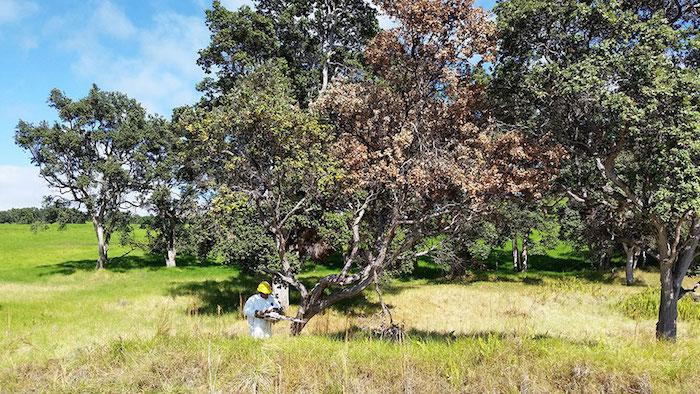
A National Park Service resource management employee fells a ROD infected ‘ōhi‘a in Kahuku/NPS
Faced with a killing fungi that threatens the future of ʻōhiʻa trees at Hawai'i Volcanoes National Park, officials are taking a crowd-sourcing approach to finding a solution to halt the threat.
“Our goal is to use the best of human ingenuity to identify technological solutions that can save part of Hawaiʻi’s beauty. This is why we look to engage innovative thinkers within other advanced technology fields through this challenge prize,” said Dr. Alex Dehgan, CEO of Conservation X Labs, which is working with federal and state agencies on the problem. “We don’t have to accept ʻōhiʻa’s extinction.”
The so-called "‘Ōhiʻa Challenge"is named after a Hawaiian legend that tells of the love and separation of the young couple ʻŌhiʻa and Lehua; Jealous of their love, the goddess Pele turned the warrior ʻŌhiʻa into a tree and Lehua into the tree’s flower. If you pluck the red lehua blossoms of the ʻōhiʻa tree (Metrosideros polymorpha), legend says the lovers’ tears fill the sky with rain as they are separated again.
Today, the tears of many others are being shed over the future of the ʻōhiʻa tree because it is threatened by microscopic fungi that recently invaded the islands of Kaua‘i and Hawai‘i. These invasive fungi, Ceratocystis huliohia and Ceratocystis lukuohia, are responsible for the phenomenon named “Rapid ‘Ōhiʻa Death” or ROD. Since 2014 when they were first identified, the fungi have infected thousands of acres of forest. If unstopped, it's believed they could irreversibly change Hawai‘i’s ecosystems and culture by eliminating the beloved ʻōhi‘a.
"When invasive species reach our shores, they care little for whether the lands are federal, state, local, or private,” said Scott J. Cameron, U.S. Department of the Interior principal deputy assistant secretary for policy, management, and budget. “Cooperation and innovation are needed when confronting the issue of invasive species, and the ʻŌhi‘a Challenge is a step forward in addressing that need. We must be good neighbors and seek ways to solve this problem together."
Hawai‘i Volcanoes National Park, U.S. Department of the Interior Office of Native Hawaiian Relations, Hakalau Forest National Wildlife Refuge, and National Invasive Species Council Secretariat are working in partnership with Conservation X Labs on this innovative challenge to address ROD by harnessing emerging science, technological innovations, and the ingenuity of people around the world. “We are incorporating industry innovation, best science, and best practices to improve environmental stewardship,” said Interior’s Susan Combs, senior advisor to the secretary.
Conservation X Labs hosts the Digital Maker Space; a platform where science, entrepreneurship, and technology communities come together to start projects and co-create tech-enabled solutions to conservation problems.
On the ‘Ōhiʻa Challenge page, anyone can submit a project that provides solutions that identify infected trees early, minimize the spread, and eliminate the pathogens, with the goal of saving Hawai‘i’s iconic ‘ōhi‘a tree. According to Cindy Orlando, superintendent for Hawai‘i Volcanoes National Park: “If ʻōhiʻa is lost, the countless native species that grow in the shade of the ʻōhiʻa will never be, the native birds that rest in the boughs of the ‘ōhi‘a and koa trees will have no roost, and rain that falls in Hawai‘i’s old growth forests will merely rush away, taking delicate island soils with it. Even the cycle of creation after a lava flow would be disrupted when there is no ʻōhiʻa to help bring life back to the land.”

'Ōhi'a lehua (Metrosideros polymorpha)/Joy Viola, Northeastern University
The Department of the Interior has provided a seed purse for the challenge prize. Conservation X Labs is seeking additional sponsors and partners to increase the prize purse and promote the challenge among diverse solver communities. Most importantly, the challenge prize team is calling on the technology community to help solve the problem.
The needs are known: identify trees that have been infected with the Ceratocystis huliohia and Ceratocystis lukuohia fungi before they die, and prevent the spread of the fungi and the infection of new trees. The end goal is to develop a treatment for infected trees and ultimately eliminate the pathogen in Hawai‘i’s forests. While the needs and goals are clear, how they are achieved is not.
“Someone somewhere out there has the vision and technological capacity to turn ‘we can’t’ into ʻwe can!’ This challenge prize will be awarded to that hero or team of heroes,” said Dr. Jamie K. Reaser, executive director of NISC.
Interested in becoming part of the coalition to save the ‘ōhi‘a and protect Hawaiʻi’s natural heritage? Visit www.SavetheOhia.org to sign up for updates or express interest in partnering.





